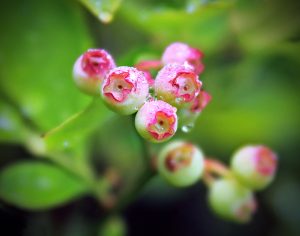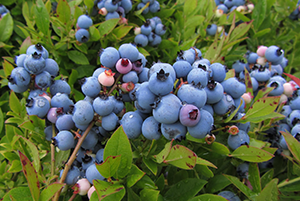Lowbush Blueberry Fact Sheet

The lowbush blueberry is the state fruit of Maine and a favorite native shrub. The range includes the northeastern United States and eastern and central Canada. Lowbush blueberries are a deciduous shrub that prefers acidic, well-drained soil with partial to full sun. The plants are fire-tolerant and can increase in number following a forest fire. Habitats that are favorable to growth can result in a natural barren where the lowbush blueberry is the dominant species across a large area. This native plant is grown commercially in many places across the northeast, including Maine. In addition to commercial harvest, lowbush blueberries are harvested recreationally and consumed by species as diverse as black bears, foxes, deer, birds, and porcupines.
Leaves: Lowbush blueberry has simple, lanceolate leaves in an alternate arrangement and serrulate margins. The leaf color is dark green in summer and reddish-bronze in fall.
Flowers: The white, bell-shaped flowers are around 5mm long and bloom in May.
Fruit: The edible fruit vary in color from a bright blue to bluish-black and are sweet to taste. The fruit are typically mature in mid- to late-summer.
Bark: The stems are reddish in color. A single bud can produce several blossoms and a healthy stem can support multiple buds.

Sources and Additional Information:
USA Phenology Network: Observing Plants and Animals – http://www.usanpn.org/Vaccinium_angustifolium . 22 February 2018.
University of Connecticut, College of Agriculture, Health and Natural Resources: Plant Database – Vaccinium angustifolium. 27 February 2018.
Lady Bird Johnson Wildflower Center: Plant Database – Vaccinium angustifolium. 27 February 2018.
